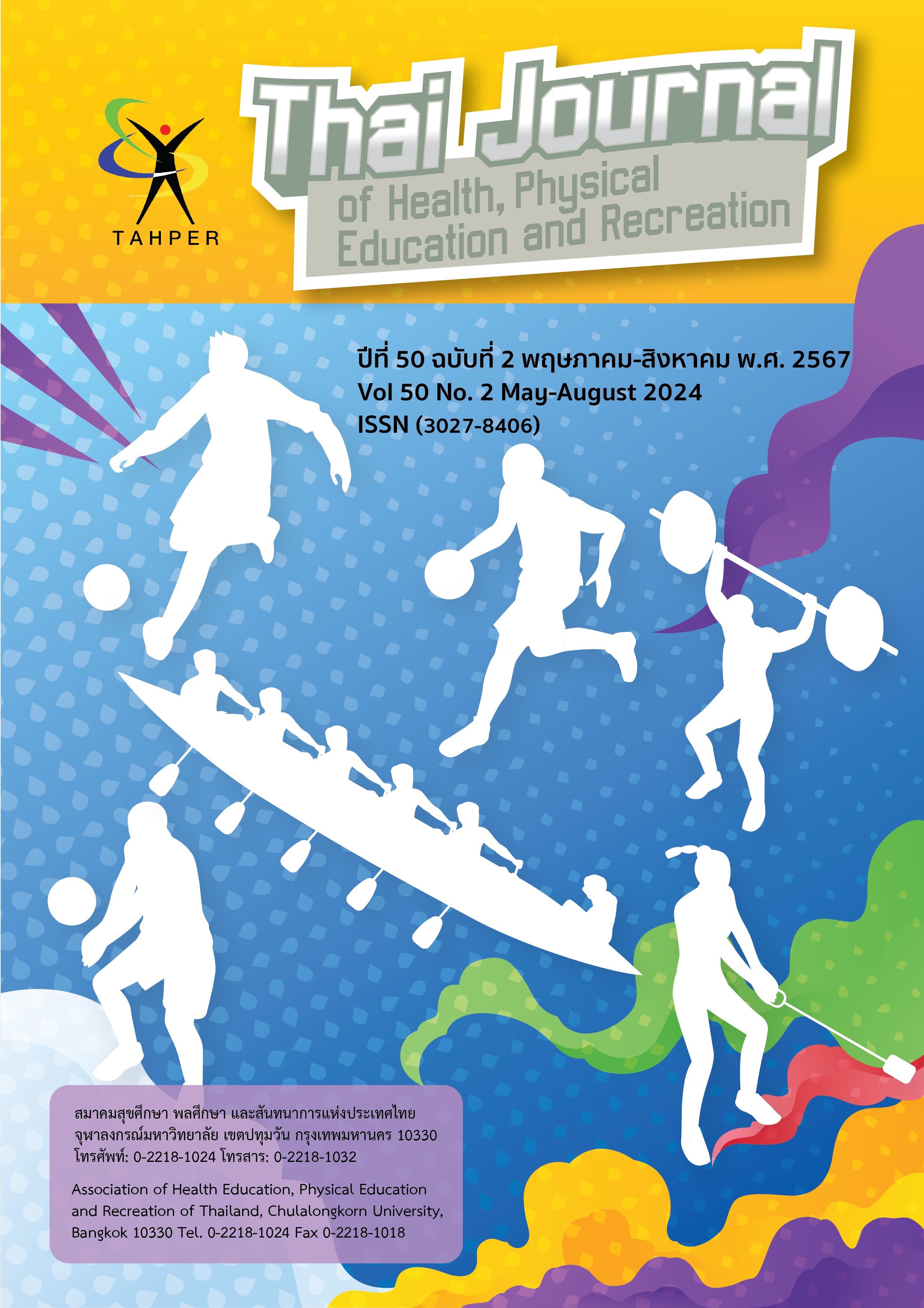The Construction of Response Time Machine in Sabre Fencing
Main Article Content
Abstract
Response times are important especially fencing athletes. There is currently only a reaction time test for physical fitness of fencing athletes but there is evident lack of the reaction time testing tools in Sabre fencing. This research was to construct the response time machine and to examine the reliability and validity of the response time machine in sabre fencing. The participants used in this research were 20 Kasetsart University fencer athletes. The index of item- objective congruence (IOC) was used to evaluate the face validity of Response time machine by 7 experts. The reliability was evaluated by test-retest method and analyzed by Pearson Product Moment Correlation Coefficient. The results found that the face validity of the response time machine was in a excellent level and the reliability was in good level (.892). It can be concluded that response time machine in sabre fencing was suitable for measuring response time in sabre fencing.
Article Details

This work is licensed under a Creative Commons Attribution-NonCommercial-NoDerivatives 4.0 International License.
Critical thinking in journals is the right of the author. The Association of Health Education, Physical Education and Recreation of Thailand is not always required, to create diversity in ideas and creativity.
ความคิด ข้อวิพากษ์ในวารสารเป้นสิทธิของผู้เขียน สมาคมสุขศึกษา พลศึกษา และสันทนาการแห่งประเทศไทยไม่จำเป็นต้องเห็นชอบด้วยเสมอไป เพื่อให้เกิดความหลากหลายในความคิดและความสร้างสรรค์
References
เกียรติขจร ก่อเกียรติพิทักษ. (2557). ผลของการฝึกสมาธิแบบไท้เก๊กที่ส่งผลต่อความแม่นยำในการแทงเป้าดาบฟอยล์และดาบเอเป้. วิทยานิพนธ์ศึกษาศาสตรมหาบัณฑิต สาขาวิชาหลักสูตรและการสอน, มหาวิทยาลัยสงขลานครินทร์.
เจริญ กระบวนรัตน์. (2557). วิทยาศาสตร์การฝึกสอนกีฬา : Science of Coaching. กรุงเทพฯ: บริษัท สินธนาก๊อปปี้เซ็นเตอร์ จำกัด.
ณัฐวุฒิ ไวโรจนานันต์. (2559). การสร้างเครื่องทดสอบเวลาปฏิกิริยาการตอบสนองของการทำงานระหว่างตากับการเคลื่อนไหวของร่างกายไปยังตำแหน่งเป้าหมายเพื่อใช้ในกีฬาแบดมินตัน. วิทยานิพนธ์ศิลปศาสตรมหาบัณฑิต สาขาวิชาพลศึกษา, มหาวิทยาลัยเกษตรศาสตร์.
บุญส่ง โกสะ. (2542). วิธีวิจัยทางพลศึกษา. กรุงเทพฯ: สำนักส่งเสริมและฝึกอบรม, มหาวิทยาลัยเกษตรศาสตร์ วิทยาเขตบางเขน.
______. (2547). การวัดผลและประเมินผลทางพลศึกษา. กรุงเทพฯ: โรงพิมพ์สำนักส่งเสริมและฝึกอบรม มหาวิทยาลัยเกษตรศาสตร์.
สมาคมฟันดาบแห่งประเทศไทยฯ. (2552ก). ประเภทกีฬาดาบสากล. สืบค้นเมื่อ 28 สิงหาคม 2562, สืบค้นจาก http://www.thaifencing.org/extensions.html.
______. (2552ข). OPEN EYES ATTACKS. สืบค้นเมื่อ 28 สิงหาคม 2562, สืบค้นจาก http://thaifencing.org/index.php?option=com_content&view=frontpage&Itemid=73&limitstart=981&mode=addshout.
สิทธิชัย ผิวเหลือง. (2562). การสร้างเครื่องมือวัดพลังการเตะในกีฬามวยไทย. วิทยานิพนธ์ศิลปศาสตรมหาบัณฑิต สาขาวิชาพลศึกษา, มหาวิทยาลัยเกษตรศาสตร์.
สุวิมล ตั้งสัจพจน์. (2526). การวัดผลและประเมินผลทางพลศึกษา. กรุงเทพฯ: ภาควิชาพลศึกษา คณะศึกษาศาสตร์ มหาวิทยาลัยเกษตรศาสตร์.
สุรปรีย์ รัตนกุล. (2553). ผลการฝึกกล้ามเนื้อด้วยเมดิซีนบอลที่มีต่อความสามารถในการโถมแทงกีฬาดาบสากล. วิทยานิพนธ์วิทยาศาสตรมหาบัณฑิต สาขาวิทยาศาสตร์การกีฬา,มหาวิทยาลัยศรีนครินทรวิโรฒ.
วิริยา บุญชัย. (2529). การทดสอบและวัดผลทางพลศึกษา. กรุงเทพฯ: ไทยวัฒนาพานิช.
Balkó, Š., Zbigniev, B., & Simonek, J. (2016). The Influence of Different Performance Level of Fencers on Simple and Choice Reaction Time. Revista Brasileira de Cineantropometria e Desempenho Humano, 18, 391-400. doi:10.5007/1980-0037.2016v18n4p391
Boonchai, W. (1986). Karntodsob lae watphon thang palasuesa. Bangkok: Thaiwatna Phanish.
Borysiuk, Z., & Cynarski, W. J. (2009). Reaction time and movement time types of sensorimotor responses and fencing tempo. Journal of Martial Arts Anthropology, 9, 189-200.
Çolakoğlu, H., Akgün, N., Yalaz, G., & Ertat, A. (1987). The Effects of Velocity Training on Aqustics and Visual Reaction Time. The Journal of Spor Hekimliği, 22(1), 43.
Favero. (2019). eft-1. Retrieved from https://www.favero.com/en2_fencing_sport_eft_1_electronic_fencing_target-183-17.html
FIE. (2018). FIE history. Retrieved from https://fie.org/fie/history.
Kirkendall, D. R., Gruber, J. J., & Johnson, R. E. (1987). Measurement and evaluation for physical educators. Champaign: Human Kinetics.
Pérez, Ó. M. d. Q., Morales, F. S., Adán, E., & Quintana, M. S. (2008). Reaction time on fencing and karate high level athletes.
Roi, G., & Bianchedi, D. (2008). The science of fencing: implications for performance and injury prevention. Sports medicine (Auckland, N.Z.), 38, 465-481.
Torun, V., Ince, G., & Durgun, B. (2012). The effects of basic fencing studies and velocity training on reaction time in the 9-12 year-old beginners of fencing. Sport Science, 5.
Weichenberger, M., Schilling-Kästle, V., Mentz, L., Engleder, T., & Hessling, M. (2015). A fencing robot for performance testing in elite fencers. Sports Technology, 8(3-4), 95-99. doi:10.1080/19346182.2015.1108326.


